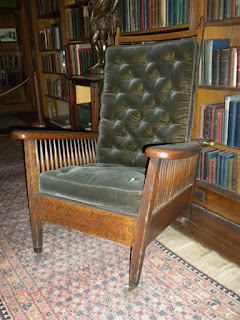NOTE: Since this
article was first posted in December 2011, there has been considerable
discussion as to whether this chair was, in fact, produced by Morris &
Co. Although a reputable appraiser in
Chicago did identify it as such, it appears that the chair may have been made
by A. H. Davenport & Co., the Boston-based company which produced numerous
pieces of furniture for the Glessners when they moved into their new home on
Prairie Avenue in 1887. Several key
features of our chair including the shape of the spindles and arms, the shape
and splay of the front legs, and the cut, color, and finish of the quarter-sawn
oak have been identified as iconic trademarks of Davenport work, and not at all
typical of the similar chairs being made by Morris & Co. (January 2, 2014)
The museum is proud to have an example of one of the most admired furniture designs of Morris & Company: the adjustable-back Morris chair. Big, roomy, and incredibly comfortable, it is a chair in which one of the Glessners could easily spend an evening reading by the fire. The chair has wide arms to accommodate books, a loose cushioned seat, and a reclining back that is adjustable by a hinge at the base and held secure with a brass rod across the back (see detail photo below). In a sense, this was the first Lazy-boy (albeit the former is arguably a more striking composition). The original Morris chair - as it is simply referred to today - was designed by Philip Webb in 1866 for Morris & Co. At the time, the company’s business manager, Warington Taylor, recommended that Webb create a chair based on one he had seen belonging to an old Sussex carpenter.
Eventually many variations of the design were being produced in different styles (Flemish, Spanish, Mission), materials (oak, mahogany), and price points ($4.25- $100). By 1905, nearly every manufacturer at the New York Furniture Exchange displayed some form of the chair and it went on to become a must-have for every household in America.
Webb’s design is the most common; however it is not the style that the Glessners chose. William Watt, another designer for Morris & Co., designed our Morris chair in 1883. The two styles, though not far apart in age, are quite different. Webb’s design is more formal with beaded scrolling and a slightly curved frame - more reminiscent of the Queen Anne style, while Watt’s simplistic form is a nice example of arts and crafts design.
Our Morris chair, located in the library, has an oak frame and is upholstered in green velvet. An historic photograph of the library taken in 1888 shows that the Morris chair was originally upholstered in a patterned fabric. It seems highly probable that a William Morris designed upholstery was used to match or compliment the adjacent sofa which also shows a richly patterned fabric.
Contributed by Jessica Blemker-Ferree (Intern, 2010)








